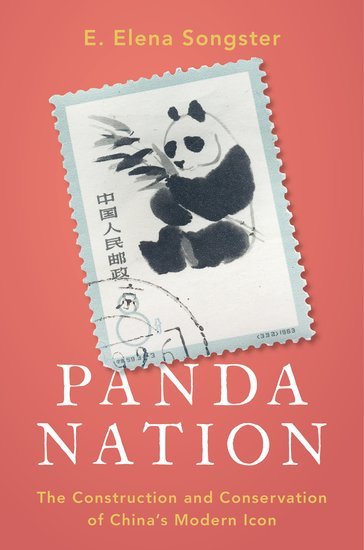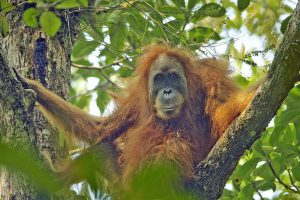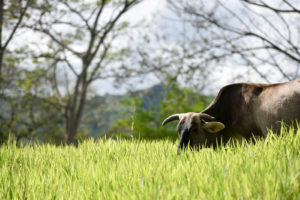China announced ambitious plans in 2017 to establish a series of large-scale national parks, some to become the world’s largest. The expressed purpose of several of these parks, distinct from national level nature protection reserves, is to target specific high-profile animal species on a grand scale. Unsurprisingly, a giant panda park is included among the plans. This Giant Panda National Park is designed to bring together the many isolated populations of giant pandas that exist in tens of small reserves across half a dozen different mountain ranges. It is a monumental investment in China’s iconic animal ambassador. In addition to the giant panda park, China is also working on a tiger park, Tibetan antelope park, and an elephant park. Not all the new national parks will focus on a specific species, some – like the Sanjiangyuan park in Qinghai on the Tibetan plateau – are designed to better preserve China’s vital water sources and the stunning natural beauty.
 Some people see a large park named as a protection zone for a specific animal as misguided and excessive emphasis on the conservation of charismatic megafauna; others consider this approach simply to be a pragmatic means to protect many less known, and less attractive but ecologically important species. Indeed, money raised for pandas brings substantial benefit to the biosphere that surrounds these popular icons and beyond.
Some people see a large park named as a protection zone for a specific animal as misguided and excessive emphasis on the conservation of charismatic megafauna; others consider this approach simply to be a pragmatic means to protect many less known, and less attractive but ecologically important species. Indeed, money raised for pandas brings substantial benefit to the biosphere that surrounds these popular icons and beyond.
But does the panda have any innate value? As early as the 1950s and 1960s, even scientists and government officials saw value in preserving the giant panda along with other unique species and China’s natural beauty as part of scientific approaches to building a socialist state.
The history of creating nature protection reserves in the People’s Republic of China (PRC) dates back almost to the nation’s founding and panda reserves were the first species-specific reserves that China established. Chinese scientists discussed nature reserves at length with their Soviet counterparts along with other scientific projects. In 1956, the PRC created Dinghu Shan, its first nature reserve in the southern province of Guangdong, after a group of five members of the Chinese Academy of Sciences (CAS), including vice-president Zhu Kezhen, presented a proposal at the Third Plenum of the First National People’s Congress. This reserve was intended to facilitate research on and to discover natural organisms and other resources that could benefit society as a whole. Changbai Shan, located in the temperate region of the northeastern province of Jilin, was the next reserve established, offering a very different climate for research.
The giant panda… was valuable and worth protecting because it was unique biologically and unique to China.
Scientists at the time were also interested in China’s special species. Biologist Jin Jieliu argued in a 1957 article that a rare indigenous species could serve the important purpose of a natural monument – a tribute to China’s natural wealth. Jin thought that a species played such a role most effectively if it was unique to a region or country, offering the example of the giant panda. The giant panda thus was valuable and worth protecting because it was unique biologically and unique to China.
There was a sudden upsurge of domestic interest in the Giant Panda during the 1950s that only grew over the subsequent decades. Early interest can be most directly attributed to the arrival of three giant panda cubs to the National Zoo in Beijing in 1955 and the accompanying news articles.
During the decades prior to this event, the giant panda had mostly been a subject of western fascination that stemmed from the fact that it did not fit well into western taxonomic categories. Debates about the giant panda’s taxonomy drew western hunters and trappers to China during the early 1900s. Of course, China was engaged in armed struggle and warfare for most of the first half of the 20th century and its people had little time or energy to think about its unique wildlife at the time.
Soon commentators were writing essays about the unique and little understood animal’s usefulness for teaching the masses to think scientifically. Early emphasis on the fact that the giant panda is only found in China heightened domestic interest in the animal. Even without formal surveys to confirm that the giant panda was few in number, the animal’s elusiveness gave the strong impression that it was scarce. The panda’s biological uniqueness, exclusive endemic status, and seeming rareness all contributed to it being named one of China’s nine precious and rare species in need of protection in a 1959 list.
China created its first species-specific reserve during the early 1960s. A State Council directive in 1962 designated nineteen animals as “precious and rare” and called upon the provinces that provided habitat for those animals to set aside nature protection areas for them. Hunting any of these nineteen species was “strictly prohibited” as opposed to “economically beneficial” animals in the second tier of animal protection.
Provincial and local officials in Sichuan, recognising that their province contained primary panda habitat, were the first to respond to this directive. Within three years Pingwu county in northern Sichuan created China’s first panda protection reserve, the Wanglang Nature Protection Reserve, quickly followed by Wolong, which initially was a forest protection area.

Baby giant pandas are bottlefed in Chengdu (Image: Chengdu Research Base of Giant Panda Breeding)
At the time the giant panda’s biological uniqueness was not valued for its money-making potential. In fact, for the first couple decades under the PRC government, people saw the giant panda as lacking economic value. The government based their desire to protect the giant panda on the notion that it was “more than simply economically valuable or important for scientific interest”.
For China, the early 1960s was a period of relative isolation from western industrialised nations. The popularity of the giant panda in the west had little bearing on China’s decision to create reserves to protect its giant pandas and other precious species at the time. Policy writers felt a sense of national pride and duty to protect species that were unique to China irrespective of external opinion.
Until the 1970s, the giant panda had a dual existence. Outside China, the giant panda became a symbol of wildlife protection when the World Wildlife Fund (WWF) adopted it as their symbol in 1961. Within China the animal was usually used to express national pride. When China formally offered state-gift pandas to other nations during the 1970s and early 1980s the giant panda became an animal ambassador and the two worlds converged.
China’s current national parks strategy reflects not only awareness of the outside world, but also includes integrated effort and exchange in the plans to achieve it. China’s early expression of national pride in its unique biological diversity is strikingly present in this more recent manifestation of nature protection.
My Book, Panda Nation: The Construction and Conservation of China’s Modern Icon examines the twentieth-century emergence of the giant panda as a national symbol. China’s nature protection policy coevolved with the giant panda’s transformation from an elusive biological oddity to the world’s most beloved animal. The giant panda’s modern history interweaves the struggles of local ethnic minorities, national economic growth and foreign diplomacy as it punctuates the centrality of the natural environment in China’s effort to forge its own national identity.








